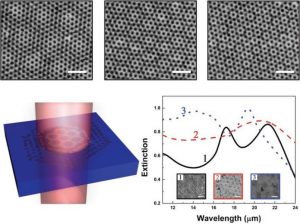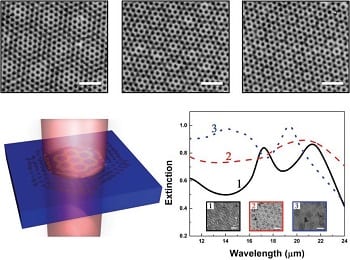Graphene has initiated a revolution in materials science and engineering. This single atomic layer of carbon exhibits extraordinary mechanical, thermal, optical, and electrical properties, leading to a new class of materials and ultra-thin devices with high performances. For example, graphene-based materials are being pursued intensely for applications in optoelectronics, including biomedical sensing, photon detection, and light modulation. However, the weak light-matter interaction and narrow-band electromagnetic response of graphene has limited some of the optoelectronic applications.
 Recently, Zheng and co-workers at the University of Texas at Austin have reported a novel way towards enhancing the optical response of graphene in a wide range of the electromagnetic spectrum. More specifically, they created moiré patterns on graphene to generate a graphene moiré metasurface. The metasurface features variable graphene structures of nanometer or micrometer sizes, arranged in moiré patterns. At the microscale and below, graphene supports localized surface plasmon resonances (LSPRs), the light-coupled coherent oscillation of free electrons in graphene. Their experiments and simulations revealed that the excitation of LSPRs can significantly enhance the light-matter interaction of the graphene moiré metasurface.
Recently, Zheng and co-workers at the University of Texas at Austin have reported a novel way towards enhancing the optical response of graphene in a wide range of the electromagnetic spectrum. More specifically, they created moiré patterns on graphene to generate a graphene moiré metasurface. The metasurface features variable graphene structures of nanometer or micrometer sizes, arranged in moiré patterns. At the microscale and below, graphene supports localized surface plasmon resonances (LSPRs), the light-coupled coherent oscillation of free electrons in graphene. Their experiments and simulations revealed that the excitation of LSPRs can significantly enhance the light-matter interaction of the graphene moiré metasurface.
Due to the high sensitivity of LSPRs to the geometry of graphene, the gradient features in the moiré patterns also lead to plasmonic responses at multiple wavelengths and thus broadened the working bandwidth of graphene-based devices. Therefore, the research team has developed a cost-effective and high-throughput method, known as moiré nanosphere lithography (MNSL), to fabricate the graphene moiré metasurface. The MNSL allows the moiré patterns to be precisely tuned, which expands the working bands of the graphene metasurfaces over a wide range from mid-infrared to terahertz regimes. With their enhanced optical response and working bandwidth, the graphene moiré metasurfaces will help improve the various graphene-based applications in communication, national security, and biomedicine.

















